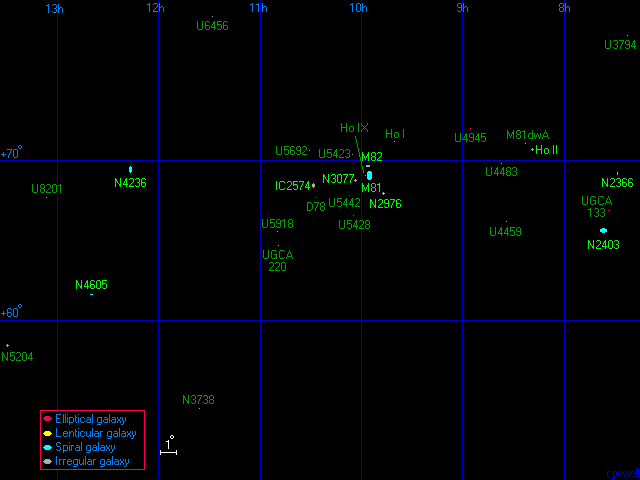
The M81 group is another famous group of galaxies mainly because it contains the famous M81/M82 pair of galaxies discovered in 1784. NGC 2403 is another prominant spiral galaxy on the right side of the group. M82 is a famous example of a starburst galaxy - there is a lot of star formation occuring in this galaxy.

Below - three galaxies in the right side of the M81 group. NGC 2366 (left) is an irregular galaxy where a lot of recent star formation has occured. The brightest part of this galaxy is known as NGC 2363 - it is a huge HII region (emission nebula) where a lot of bright blue stars have formed. NGC 2403 (centre) is the second largest galaxy in the M81 group. Holmberg II (right) is one of nine low-surface-brightness galaxies listed by Erik Holmberg in the 1950's, three of which are associated with the M81 group.
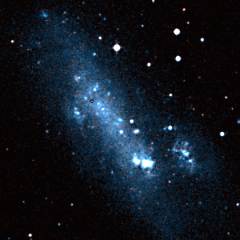 |
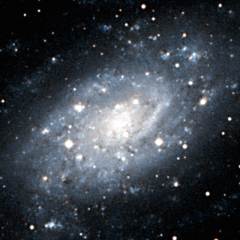 |
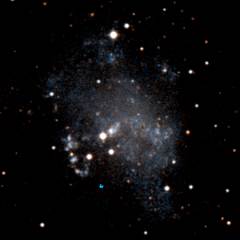 |
| NGC 2366 | NGC 2403 | Holmberg II |
This is a list of the main galaxies in the M81 group. The three main galaxies in this group are M81, NGC 2403 and NGC 4236.
1 2 3 4 5 6 7 8 9
Name Equatorial Blue Type Size Size RV Other
Coordinates Mag (') kly km/s Names
RA Dec
UGC 3794 07 22.9 +77 48 17.8 SBm 1.0 5 ?
NGC 2366 07 28.9 +69 12 11.9 Irr 8.1 30 134
UGCA 133 07 34.2 +66 53 15.9 E 3.0 10 ? DDO 44
NGC 2403 07 36.8 +65 36 8.9 SBc 21.9 75 181
Holmberg II 08 19.1 +70 43 11.1 Irr 7.9 30 207 UGC 4305
M81dwA 08 23.2 +71 02 16.5 Irr 1.8 5 163 PGC 23521
UGC 4459 08 34.2 +66 11 15.0 Irr 1.5 5 95 DDO 53
UGC 4483 08 37.1 +69 47 15.5 Irr 1.1 5 217
UGC 4945 08 55.9 +72 01 17? E 1.3 5 700 UGCA 158
Holmberg I 09 40.5 +71 11 13.2 Irr 3.6 15 208 UGC 5139
NGC 2976 09 47.3 +67 55 10.9 Sc 5.9 20 94
M81 09 55.6 +69 04 7.9 Sab 26.9 95 50 NGC 3031
M82 09 55.8 +69 41 9.2 Irr 11.2 40 296 NGC 3034
Holmberg IX 09 57.7 +69 03 14.4 Irr 2.5 10 134 UGC 5336
NGC 3077 10 03.4 +68 44 10.6 Irr 5.4 20 102
UGC 5428 10 05.1 +66 33 16.0 E 0.9 5 -22 DDO 71
UGC 5423 10 05.5 +70 22 15.9 Irr 0.9 5 424 M81dwB
UGC 5442 10 07.1 +67 49 15.4 E 1.8 5 78
DDO 78 10 26.5 +67 40 15.8 E 2.0 5 ? PGC 30664
IC 2574 10 28.4 +68 25 10.8 SBm 13.2 45 142
UGC 5692 10 30.6 +70 37 13.5 Sm 3.2 10 262 DDO 82
UGCA 220 10 49.3 +64 43 16.9 Irr 1.7 5 ?
UGC 5918 10 49.6 +65 32 15.1 Irr 2.4 10 452 DDO 87
UGC 6456 11 28.0 +78 59 15.9 Irr 1.4 5 -61
NGC 3738 11 35.8 +54 31 12.1 Irr 2.5 10 406
NGC 4236 12 16.8 +69 28 10.1 SBd 21.9 75 87
NGC 4605 12 40.0 +61 37 10.9 SBc 5.8 20 272
UGC 8201 13 06.5 +67 42 12.9 Irr 3.5 10 121 DDO 165
NGC 5204 13 29.6 +58 26 11.7 Sm 5.0 15 329
|
Column 1: The usual name of the galaxy.
Column 2: The Right Ascension for epoch 2000.
Column 3: The Declination for epoch 2000.
Column 4: The blue apparent magnitude of the galaxy.
Column 5: The galaxy type: E=Elliptical, S0=Lenticular, Sa,Sb,Sc,Sd=Spiral,
SBa,SBb,SBc,SBd=Barred Spiral, Sm,SBm,Irr=Irregular.
Column 6: The angular diameter of the galaxy (arcminutes).
Column 7: The diameter of the galaxy (thousands of light years).
Column 8: The recessional velocity (km/s) of the galaxy relative to
the cosmic microwave background.
Column 9: Other names of the galaxy.
References:
Karachentsev I, Dolphin A, Geisler D, Grebel E, Guhathakurta P, Hodge P, Karachentseva V,
Sarajedini A, Seitzer P, Sharina M, (2002), The M 81 group of galaxies: New
distances, kinematics and structure. Astron and Astrophys, 383, 125.
van Driel W, Kraan-Korteweg R, Binggeli B, Huchtmeier W, (1998), An HI line search for
optically identified dwarf galaxy candidates in the M 81 group. Astron and
Astrophys Supp, 127, 397.
Schmidt K, Priebe A, Boller T, (1993), Nearby Galaxies. Astron Nachr, 314, 371.
The HyperLeda Database, (2003).
Below - three more M81 group galaxies. M82 (left) is a very famous example of a starburst galaxy - it contains a lot of young, bright stars probably because a close encounter with its more massive neighbour M81 has triggered a lot of new star formation. IC 2574 (centre) by contrast is a much dimmer galaxy even though it is approximately the same size as M82. NGC 4236 (right) is a large galaxy in the left side of the M81 group.
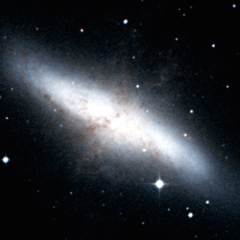 |
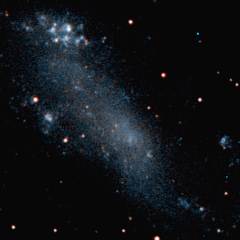 |
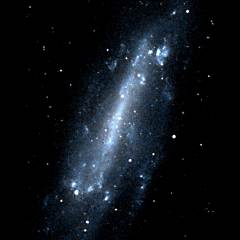 |
| M82 | IC 2574 | NGC 4236 |
Shown below is M81. This galaxy is the dominant galaxy in the group and it is similar in size to the Milky Way. This galaxy is one of the brightest galaxies in the sky, and although it is too faint to see with the naked eye, it is an easy galaxy to find with binoculars if you know where to look.
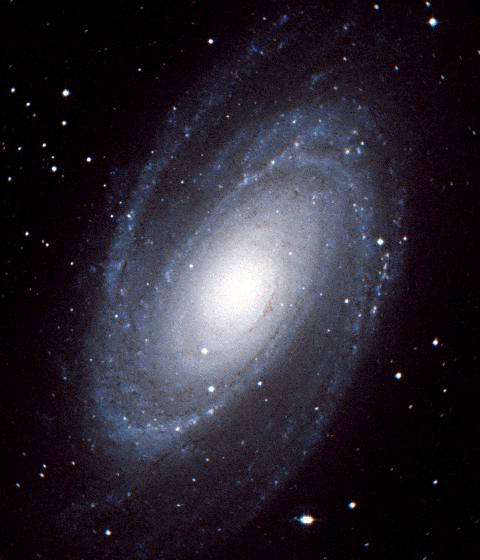
Below - three bright dwarf galaxies in the M81 group. NGC 2976 (left) is a small spiral galaxy approximately two million light years behind M81. NGC 3077 (centre) is much closer to M81 - they are separated by about 140 thousand light years. NGC 4605 (right) is a small spiral galaxy on the left edge of the group.
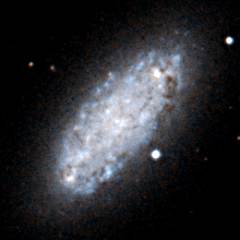 |
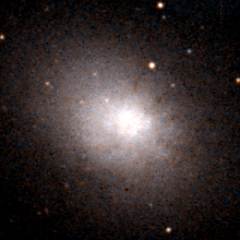 |
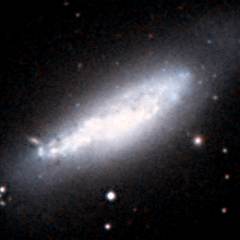 |
| NGC 2976 | NGC 3077 | NGC 4605 |
| Properties of the M81 Group | |
|---|---|
| Equatorial Coordinates | RA=10h00m Dec=+68° |
| Galactic Coordinates | l=145° b=+40° |
| Supergalactic Coordinates | L=40° B=0° |
| Distance to the centre of the group | 12 million light years |
| Number of large galaxies | 7 |